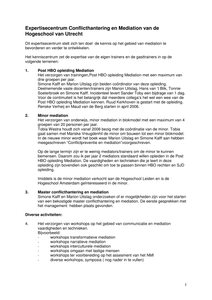Verpleegkundigen, werkzaam in de zorgpraktijk, dienen hun kennis en kunde gedurende hun carrière continu bij te houden en te ontwikkelen. Dit leidde bij het HagaZiekenhuis tot de vraag aan De Haagse Hogeschool om hun verpleegkundigen een bijscholing medische biologie te geven. Maar hoe toets je het toepassen van deze kennis in de verpleegkundige praktijk? Het hbo-v-team ontwikkelde hiervoor een nieuwe toetsvorm waarbij de medische kennis van deelnemers op toepassingsniveau wordt beoordeeld in een gesimuleerd multidisciplinair overleg. In deze leerpraktijk wordt deze toetsvorm verder toegelicht, en de eerste ervaringen van deelnemers, docenten en externe beoordelaars beschreven.
DOCUMENT
Steeds meer gemeenten hanteren in hun beleidsplannen als doelstelling van schulddienstverlening 'iedereen het maximaal haalbare' in plaats van 'iedereen schuldenvrij'. Dit vraagt dat het 'maximaal haalbare' tijdens de intake wordt vastgesteld. Gedrag, motivatie en vaardigheden zijn daarbij cruciaal. Daarom is inzicht in die aspecten noodzakelijk. Om dat inzicht op een gestructureerde manier tot stand te brengen is het methodisch screeningsinstrument schulddienstverlening (Mesis©) geconstrueerd. In dit artikel worden in kort bestek inhoud, functie, doel en werkwijze van Mesis© uiteengezet
DOCUMENT

Background and Aim: Caregivers in the home environment have an important role in timely detecting and responding to abuse. The aim of this review was to provide insight into both the existing tools for the assessment of and interventions for elder abuse by formal and informal caregivers in the home environment, and to categorize them according to a public health perspective, into primary, secondary, tertiary or quaternary prevention. Methods: We selected the assessment tools and interventions that can be used by caregivers in the home environment included in previous reviews by Gallione et al (2017) and Fearing et al (2017). To identify published studies after these reviews, a search was performed using PubMed, Cochrane Database, CINAHL and Web of Science. Results: In total, fifteen assessment tools and twelve interventions were included. The number of assessment tools for elder abuse for use in the home environment is increasing; however, tools must be validated over different cultures and risk groups. In addition, the tools lack attention for the needs of vulnerable older persons such as persons with dementia. Existing interventions for caregivers in the home environment lack evidence for addressing elder abuse and do not address potential adverse effects (quaternary prevention). Conclusion: Assessment tools for elder abuse need further testing for validity and reliability for use by caregivers in the home environment. For interventions, meaningful outcome measures are needed. Important to note is that quaternary prevention requires more attention. This argues for taking into account perspectives of (abused) older persons and caregivers in the development of assessment tools and interventions protocols.
DOCUMENT

Digitization of activities in hospitals receives more attention, due to Covid-19 related regulations. The use of e-health to support patient care is increasing and efficient ways to implement digitization of processes and other technological equipment are needed. We constructed a protocol for implementation and in this study, we evaluate this protocol based on a case to implement a device in the OR. We used various data sources to evaluate this protocol: semi-structured interviews, questionnaires, and project documents. Based on these findings, this protocol, including identified implementation activities and implementation instructions can be used for implementations of other devices. Implementation activities include setting up a project plan, organizational and technological preparation, maintenance, and training. In future research, these activities and instructions need to be evaluated in more complex projects and a flexible tool needs to be developed to select relevant activities and instructions for implementations of information systems or devices.
LINK
First year students Aeronautical Engineering had the opportunity to enter a five days program to enhance their mathematical skills. The program had 55 participants. Our research questions were: What are the effects of participation in the summer school program on math skills? Do participants experience more motivation and academic self-esteem after participation? Do dropout rates differ between participating and non-participating students? Do participants differ from non-participating students in motivation or academic self-esteem? We presented the results at the European First Year Experience in Cork, Ireland.
DOCUMENT

At the conference of the European Association for Research on Learning and Instruction (EARLI) Niels Bohnen and Suzan van Ierland presented their research about enhancing student self-regluation through prgrammatic assessment. The aim of the current study is to discover to which degree studying within a course program based on programmatic assessment enhances self-regulation of students compared to students in a traditional course program. The results of the study could provide guidelines for the implementation of self-directed learning within course programmes at HAS green academy, inparticular aimed at programmatic assessment.
DOCUMENT

De HBO-lerarenopleidingen voor het voortgezet onderwijs, het beroepsonderwijs en de volwasseneneducatie hebben het tij niet mee gehad: opleiden voor een impopulair beroep, veel directiewisselingen, een lastige zoektocht naar andere samenwerkingsvormen met scholen en moeite hun sterke kanten voor het voetlicht te brengen. Sterke kanten zijn er echter genoeg, vindt Ans Buys van de Fontys Lerarenopleiding Tilburg.
DOCUMENT

Dit expertisecentrum stelt zich ten doel de kennis op het gebied van mediation te bevorderen en verder te ontwikkelen.
DOCUMENT

DOCUMENT
